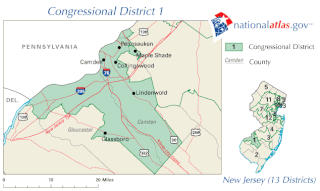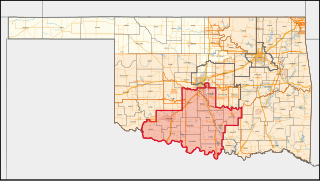
New Jersey's 1st congressional district is a congressional district in the U.S. state of New Jersey. The district, which includes Camden and South Jersey suburbs of Philadelphia, has been represented by Democrat Donald Norcross since November 2014. It is among the most reliably Democratic districts in New Jersey, as it is mainly made up of Democratic-dominated Camden County.

Maryland's 5th congressional district comprises all of Charles, St. Mary's, and Calvert counties, as well as portions of Prince George's and Anne Arundel counties. The district is currently represented by Democrat Steny Hoyer, who from 2007 to 2011 and from 2019 to 2023 was House Majority Leader.
South Dakota's 1st congressional district is an obsolete congressional district that existed from 1913 to 1983.
From its statehood in 1816 until 1823, Indiana was allocated only one representative, who was elected at-large. During the 43rd Congress, from 1873 to 1875, Indiana elected three of its thirteen representatives to the United States House of Representatives at-large from the entire state.
Pennsylvania's 34th congressional district was one of Pennsylvania's districts of the United States House of Representatives. It covered area north of the city of Pittsburgh, Pennsylvania.

Oklahoma's 4th congressional district is located in south-central Oklahoma and covers a total of 15 counties. Its principal cities include Midwest City, Norman, Moore, Ada, Duncan, Lawton/Ft. Sill, and Ardmore. The district also includes much of southern Oklahoma City.

Oklahoma's 5th congressional district is a congressional district in the U.S. state of Oklahoma. It borders all of the other congressional districts in the state except the 1st district. It is densely populated and covers most of Oklahoma County and all of Lincoln, Pottawatomie and Seminole counties, as well as parts of Canadian and Logan counties. With a Cook Partisan Voting Index rating of R+12, it is the least Republican district in Oklahoma, a state with an all-Republican congressional delegation.
The U.S. state of Pennsylvania elected its United States representatives at-large on a general ticket for the first and third United States Congresses. General ticket representation was prohibited by the 1842 Apportionment Bill and subsequent legislation, most recently in 1967.
Alabama's 8th congressional district, now obsolete, was established in 1877.
Alabama's 9th congressional district was formerly apportioned to portions of central and western Alabama from 1893 until 1963 when the seat was lost due to reapportionment after the 1960 United States census.
The state of Colorado was represented in the United States House of Representatives by one member of the House, elected at-large from 1876 until 1893 and from 1903 until 1913, and by two members at-large from 1913 until 1915. Since the 1914 elections, all members from Colorado have been elected from congressional districts.
Florida's at-large congressional district may refer to a few different occasions when a statewide at-large district was used for elections to the United States House of Representatives from Florida. The district is obsolete.
On three occasions in New York history, some members of the United States House of Representatives were elected statewide at-large. This was due to an increase of the number of representatives after the previous federal census, and the failure of the State Legislature to re-apportion the congressional districts in time for the next election.
Alabama's at-large congressional district was a congressional district for the United States House of Representatives in Alabama active at various times from 1819 to 1965. Alabama became a state in 1819, and its single representative to the 16th and 17th Congresses was elected at-large. For the 27th Congress, all five of Alabama's representatives were elected at-large, before the state gained a representative from the 1840 census. In the 43rd to 44th Congresses, the seventh and eighth representatives gained in the 1870 census were elected at-large. For the 63rd and 64th Congresses, Alabama elected the tenth of its apportioned representatives, gained in the 1910 census, at-large from the entire state. For the 88th Congress, after the state lost one representative in the 1960 census, Alabama once again elected all of their representatives at-large.
West Virginia gained a sixth seat in the United States House of Representatives after the 1910 census, but failed to adopt a new redistricting plan immediately. In 1912 and 1914, the state elected Howard Sutherland at-large from the entire state, in addition to its five districted representatives.
Alabama's 10th congressional district is an obsolete district which existed from 1917 until 1933. Its sole representative was William B. Bankhead.
South Carolina was readmitted to Congress in 1868, after passage of the 14th Amendment. That amendment ended the three-fifths rule effectively raising the population of states that once had slavery. As a result, South Carolina and other slave states tried to seat extra members of Congress. South Carolina choose two additional congress members during an at-large election in 1870. In one of those, Johann Peter Martin Epping defeated Lucius W. Wimbush by 61 votes: 71803-71742. But the House refused to seat him and the other at-large winner. "A number of southern states upon readmission claimed that since their slaves were emancipated, they were entitled to larger delegations in the House. Epping's election falls in this category. The claims were rejected by the House."
Oklahoma's 6th congressional district is a former U.S. congressional district in Western Oklahoma. Oklahoma gained three seats in the 1910 census, but elected the extra seats at-large in 1912. The 6th district was thus created and first used for the 1914 House election. Oklahoma has gradually lost seats since the 1910 census; it lost its sixth seat in the 2000 census. Since 2003, most of the territory that was in the final configuration of the 6th district has been in the 3rd district.
Oklahoma's 7th congressional district was a district that existed from 1915 through 1953, covering the southwestern portion of the state.







